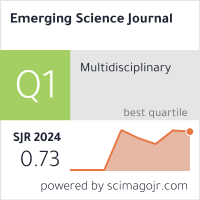Methodology for Business Process Automation in SMEs: From Requirements Analysis to Practical Demonstration
Downloads
This study aims to develop a methodology to assist Small and Medium Enterprises (SMEs) in effectively adopting Business Process Automation (BPA). Despite its growing importance in streamlining routine tasks and enabling employees to focus on more creative activities, numerous organizations face challenges in implementing BPA due to unclear procedures, insufficient knowledge of eligible processes, and uncertainty regarding the necessary technology. In response to these challenges, we introduce the Methodology for Business Process Automation (M4BPA), an artifact designed to guide SMEs through a structured BPA implementation process. The research follows the Design Science Research Methodology (DSRM). The requirements for the artifact came from the results of a previous Systematic Literature Review (SLR). M4BPA was demonstrated within real SME environments, providing solid evidence of its efficacy. The findings suggest that M4BPA significantly enhances SMEs' ability to implement BPA efficiently, offering a practical toolkit that facilitates the process. The novelty of this work lies in the development of a BPA methodology specifically tailored for SMEs, addressing existing gaps in current frameworks and providing a best-practice model for similar organizations. This research contributes to the intermediate results of a doctoral project, offering valuable insights for both practitioners and researchers in the field of BPA.
Downloads
[1] Zaoui, F., & Souissi, N. (2020). Roadmap for digital transformation: A literature review. Procedia Computer Science, 175, 621–628. doi:10.1016/j.procs.2020.07.090.
[2] Gartner. (2020). Gartner says worldwide robotic process automation software revenue to reach nearly $2 billion in 2021. Newsroom – Press Releases. Available online: https://www.gartner.com/en/newsroom/press-releases/2020-09-21-gartner-says-worldwide-robotic-process-automation-software-revenue-to-reach-nearly-2-billion-in-2021 (accessed on May 2025).
[3] Statista. (2021). SMEs in Europe – Statistics & facts. Statista Research Department, Hamburg, Germany. Available online: https://www.statista.com/statistics/1254442/digitalization-adoption-among-eu-smes/ (accessed on May 2025).
[4] IBM. (2025). RPA is essential for small and midsized enterprises to gain a competitive advantage. Available online: https://www.techtarget.com/searchcio/robotic-process-automation/RPA-Is-Essential-for-Small-and-Midsized-Enterprises-to-Gain-a-Competitive-Advantage (accessed on May 2025).
[5] Schlegel, D., Rosenberg, B., Fundanovic, O., & Kraus, P. (2024). How to conduct successful business process automation projects? An analysis of key factors in the context of robotic process automation. Business Process Management Journal, 30(8), 99–119. doi:10.1108/bpmj-06-2023-0465.
[6] Stravinskienė, I., & Serafinas, D. (2021). Process management and robotic process automation: The insights from systematic literature review. Management of Organizations: Systematic Research, 85(1), 87–106. doi:10.1515/mosr-2021-0006.
[7] Moreira, S., Mamede, H. S., & Santos, A. (2024). Business process automation in SMEs: A systematic literature review. IEEE Access, 12, 75832–75864. doi:10.1109/ACCESS.2024.3406548.
[8] Mishra, S., Sree Devi, K. K., & Badri Narayanan, M. K. (2019). People & process dimensions of automation in business process management industry. International Journal of Engineering and Advanced Technology, 8(6), 2465–2472. doi:10.35940/ijeat.F8555.088619.
[9] Ahmad, T., & Van Looy, A. (2020). Business process management and digital innovations: A systematic literature review. Sustainability, 12(17), 6827. doi:10.3390/su12176827.
[10] Enriquez, J. G., Jimenez-Ramirez, A., Dominguez-Mayo, F. J., & Garcia-Garcia, J. A. (2020). Robotic process automation: A scientific and industrial systematic mapping study. IEEE Access, 8, 39113–39129. doi:10.1109/ACCESS.2020.2974934.
[11] Flechsig, C., Anslinger, F., & Lasch, R. (2021). Robotic process automation in purchasing and supply management: A multiple case study on potentials, barriers, and implementation. Journal of Purchasing and Supply Management, 28(1), 100718. doi:10.1016/j.pursup.2021.100718.
[12] Hofmann, P., Samp, C., & Urbach, N. (2020). Robotic process automation. Electronic Markets, 30, 99–106. doi:10.1007/s12525-019-00365-8.
[13] Puica, E. (2022). How is it a benefit using robotic process automation in supply chain management? Journal of Supply Chain and Customer Relationship Management, 2022, 1–11. doi:10.5171/2022.221327.
[14] Siderska, J. (2020). Robotic process automation – A driver of digital transformation? Engineering Management in Production and Services, 12(2), 21–31. doi:10.2478/emj-2020-0009.
[15] Sobczak, A. (2019). Developing a robotic process automation management model. Informatyka Ekonomiczna, 2019(2), 85–100. doi:10.15611/ie.2019.2.06.
[16] Sobczak, A. (2022). Robotic process automation as a digital transformation tool for increasing organizational resilience in Polish enterprises. Sustainability (Switzerland), 14(3), 1333. doi:10.3390/su14031333.
[17] Syed, R., Suriadi, S., Adams, M., Bandara, W., Leemans, S. J. J., Ouyang, C., ter Hofstede, A. H. M., van de Weerd, I., Wynn, M. T., & Reijers, H. A. (2020). Robotic process automation: Contemporary themes and challenges. Computers in Industry, 115, 103162. doi:10.1016/j.compind.2019.103162.
[18] Wewerka, J., & Reichert, M. (2021). Robotic process automation – A systematic mapping study and classification framework. Enterprise Information Systems, 17(2), Article e1986862. doi:10.1080/17517575.2021.1986862.
[19] Ansari, W. A., Diya, P., Patil, S., & Patil, S. (2019). A review on RPA – The future of business organisations. 2nd International Conference on Advances in Science & Technology (ICAST-2019), Mumbai, India.
[20] Choi, D., R'Bigui, H., & Cho, C. (2021). Candidate digital tasks selection methodology for automation with robotic process automation. Sustainability (Switzerland), 13(16), 8980. doi:10.3390/su13168980.
[21] Patri, P. (2020). Robotic process automation: Challenges and solutions for the banking sector. International Journal of Management, 11(12), 322–333. doi:10.34218/ijm.11.12.2020.031.
[22] Siderska, J. (2021). The adoption of robotic process automation technology to ensure business processes during the COVID-19 pandemic. Sustainability (Switzerland), 13(14), 8020. doi:10.3390/su13148020.
[23] Zhang, C., Issa, H., Rozario, A., & Soegaard, J. S. (2021). Robotic process automation (RPA) implementation case studies in accounting: A beginning to end perspective. Accounting Horizons, 37(1), 193–217. doi:10.2308/horizons-2021-084.
[24] Sobczak, A. (2021). Robotic process automation implementation, deployment approaches and success factors – An empirical study. Entrepreneurship and Sustainability Issues, 8(4), 122–147. doi:10.9770/jesi.2021.8.4(7).
[25] Qatawneh, A. M., Lutfi, A., & Al Barrak, T. (2024). Effect of Artificial Intelligence (AI) on Financial Decision-Making: Mediating Role of Financial Technologies (Fin-Tech). HighTech and Innovation Journal, 5(3), 759–773. doi:10.28991/hij-2024-05-03-015.
[26] Hindel, J., Cabrera, L. M., & Stierle, M. (2020). Robotic process automation: Hype or hope? In WI2020 Zentrale Tracks, 1750–1762. doi:10.30844/wi_2020_r6-hindel.
[27] Jeyaraj, A., & Sethi, V. (2020). Embedding Robotic Process Automation into Process Management: Case Study of using taskt. AIS Transactions on Enterprise Systems, 5(1), 1-19.
[28] Leite, G. S., Albuquerque, A. B., & Pinheiro, P. R. (2020). Process automation in the scenario of intelligence and investigation units: An experience. Advances in Intelligent Systems and Computing, 1225, 627–641. doi:10.1007/978-3-030-51971-1_51.
[29] Vitharanage, D., Manuraji, I., Bandara, W., Syed, R., & Toman, D. (2020). An empirically supported conceptualisation of robotic process automation (RPA) benefits. In Proceedings of the 28th European Conference on Information Systems (ECIS2020), 6–15.
[30] Abidemi, A. (2024). The role of technology and automation in streamlining business processes and productivity for SMEs. International Journal of Entrepreneurship, 7(3), 25–42. doi:10.47672/ije.2510.
[31] Pardesi, S. (2024). Integrating hyper-automation with RPA and AI for end-to-end business process optimization. Darpan International Research Analysis, 12(3), 199–211. doi:10.36676/dira.v12.i3.67.
[32] Rani, R., H. J., Agrawal, T., & Varalakshmi, K. R. (2024). Transforming RPA in science & commerce. In Proceedings of the 2024 1st International Conference on Innovative Sustainable Technologies for Energy, Mechatronics and Smart Systems (ISTEMS 2024), 1–6. doi:10.1109/ISTEMS60181.2024.10560163.
[33] Hull, R., & Nezhad, H. R. M. (2016). Rethinking BPM in a cognitive world: Transforming how we learn and perform business processes. In Lecture Notes in Computer Science, 9850, 3–19. doi:10.1007/978-3-319-45348-4_1.
[34] Nurhayati, & Fitrisari, D. (2016). Business process automation of document filing based Alfresco for referral BPJS patient (case study: BPJS Center of Dharmais Cancer Hospital). 2016 International Conference on Informatics and Computing (ICIC), 406–410. doi:10.1109/IAC.2016.7905753.
[35] Athanasopoulos, K., Nikoletos, G., Georgiadis, G., Stamelos, I., & Skolarikis, S. (2017). Process management in the Greek public sector: A case study in the municipality of Kalamaria. ACM International Conference Proceeding Series, Part F1325, 1–6. doi:10.1145/3139367.3139467.
[36] Alves, C., Valença, G., & Fraga, G. (2018). Integrating requirements and business process models in BPM projects. Proceedings of the 44th Euromicro Conference on Software Engineering and Advanced Applications (SEAA 2018), 273–280. doi:10.1109/SEAA.2018.00052.
[37] Denner, M. S., Püschel, L. C., & Röglinger, M. (2018). How to exploit the digitalization potential of business processes. Business and Information Systems Engineering, 60(4), 331–349. doi:10.1007/s12599-017-0509-x.
[38] Torkhani, R., Laval, J., Malek, H., & Moalla, N. (2018). Intelligent framework for business process automation and re-engineering. International Conference on Intelligent Systems (IS), 624–629.
[39] Ahmad, T., & Van Looy, A. (2019). Reviewing the historical link between business process management and IT: Making the case towards digital innovation. Proceedings of the International Conference on Research Challenges in Information Science (RCIS), 1–12. doi:10.1109/RCIS.2019.8877039.
[40] Dumčius, M., & Skersys, T. (2019). Improvement and digitalization of business processes in small-medium enterprises. CEUR Workshop Proceedings, 2470, 22–27.
[41] Huang, F., & Vasarhelyi, M. A. (2019). Applying robotic process automation (RPA) in auditing: A framework. International Journal of Accounting Information Systems, 35, 100433. doi:10.1016/j.accinf.2019.100433.
[42] Hartley, J. L., & Sawaya, W. J. (2019). Tortoise, not the hare: Digital transformation of supply chain business processes. Business Horizons, 62(6), 707–715. doi:10.1016/j.bushor.2019.07.006.
[43] Ludacka, F., Duell, J., & Waibel, P. (2019). Global accounting with the TIM BPM Suite at Deutsche Bahn Group. CEUR Workshop Proceedings, 2428, 130–141.
[44] König, M., Bein, L., Nikaj, A., & Weske, M. (2020). Integrating robotic process automation into business process management. In Lecture Notes in Business Information Processing, 393, 132–146. doi:10.1007/978-3-030-58779-6_9.
[45] Leon, A. T. (2020). Framework for the automation of business processes. International Journal of Systems Engineering, 4(1), 11. doi:10.11648/j.ijse.20200401.11.
[46] Noppen, P., Beerepoot, I., van de Weerd, I., Jonker, M., & Reijers, H. A. (2020). How to keep RPA maintainable? In Lecture Notes in Computer Science, 12168, 414–430. doi:10.1007/978-3-030-58666-9_26.
[47] Susilo, A., Prabowo, H., Kosasih, W., Kartono, R., & Utami Tjhin, V. (2021). The implementation of robotic process automation for banking sector: Case study of a private bank in Indonesia. ACM International Conference Proceeding Series, 365–371. doi:10.1145/3512576.3512641.
[48] Costa, D. A. da S., Mamede, H. S., & da Silva, M. M. (2022). Robotic process automation (RPA) adoption: A systematic literature review. Engineering Management in Production and Services, 14(2), 1–12. doi:10.2478/emj-2022-0012.
[49] Feio, I. C. L., & dos Santos, V. D. (2022). A strategic model and framework for intelligent process automation. In 2022 Iberian Conference on Information Systems and Technologies (CISTI), 9820099. doi:10.23919/CISTI54924.2022.9820099.
[50] Herm, L. V., Janiesch, C., Helm, A., Imgrund, F., Hofmann, A., & Winkelmann, A. (2022). A framework for implementing robotic process automation projects. Information Systems and e-Business Management, 1-35. doi:10.1007/s10257-022-00553-8.
[51] Lazareva, N., Karasevskis, K., Girjatovcs, A., & Kuznecova, O. (2022). Business process automation in retail. In 2022 63rd International Scientific Conference on Information Technology and Management Science (ITMS 2022), 9937096. doi:10.1109/ITMS56974.2022.9937096.
[52] Liutkevičienė, I., Rytter, N. G. M., & Hansen, D. (2022). Leveraging capabilities for digitally supported process improvement: A framework for combining Lean and ERP. Business Process Management Journal, 28(3), 765–783. doi:10.1108/BPMJ-05-2021-0296.
[53] Neto, U. T., Oliveira, T., Pillat, R., Alencar, P., Cowan, D., & Melo, G. (2022). AKIP process automation platform: A framework for the development of process-aware web applications. WEBIST 2022 – Proceedings of the International Conference on Web Information Systems and Technologies, 64–74. doi:10.5220/0011550000003318.
[54] Smirnov, A., Kashevnik, A., Shilov, N., Teslya, N., Petrov, M., Sinko, M., Arneving, J., Humpf, M., & Kolmer, T. (2022). Product configuration automation: Digital transformation platform and case study. IN4PL 2022 – Proceedings of the 3rd International Conference on Innovative Intelligent Industrial Production and Logistics, 115–122. doi:10.5220/0011524100003329.
[55] Moreira, S., Mamede, H. S., & Santos, A. (2023). Business process automation in SMEs. Lecture Notes in Business Information Processing, 464, 426–437. doi:10.1007/978-3-031-30694-5_31.
[56] Gandía, J. A. G., Gavrila, S. G., Ancillo, A. de L., & del Val Núñez, M. T. (2024). RPA as a challenge beyond technology: Self-learning and attitude needed for successful RPA implementation in the workplace. Journal of the Knowledge Economy, 1-28. doi:10.1007/s13132-024-01865-5.
[57] Chakraborti, T., Isahagian, V., Khalaf, R., Khazaeni, Y., Muthusamy, V., Rizk, Y., & Unuvar, M. (2020). From robotic process automation to intelligent process automation: Emerging trends. Lecture Notes in Business Information Processing, 393, 243–256. doi:10.1007/978-3-030-58779-6_15.
[58] van der Aalst, W. M. P. (2013). Business process management: A comprehensive survey. ISRN Software Engineering, 2013, 1–37. doi:10.1155/2013/507984.
[59] Eulerich, M., Pawlowski, J., Waddoups, N. J., & Wood, D. A. (2022). A framework for using robotic process automation for audit tasks. Contemporary Accounting Research, 39(1), 691–720. doi:10.1111/1911-3846.12723.
[60] Martinek-Jaguszewska, K., & Rogowski, W. (2022). Development and validation of the business process automation maturity model: Results of the Delphi study. Information Systems Management, 40(2), 1–17. doi:10.1080/10580530.2022.2071506.
[61] Šperka, R., & Halaška, M. (2022). The performance assessment framework (PPAFR) for RPA implementation in a loan application process using process mining. Information Systems and e-Business Management, 277-321. doi:10.1007/s10257-022-00602-2.
[62] Szelągowski, M. (2021). Practical assessment of the nature of business processes. Information Systems and e-Business Management, 19(2), 541–566. doi:10.1007/s10257-021-00501-y.
[63] Wellmann, C., Stierle, M., Dunzer, S., & Matzner, M. (2020). A framework to evaluate the viability of robotic process automation for business process activities. In Lecture Notes in Business Information Processing, 393, 200–214. doi:10.1007/978-3-030-58779-6_14.
[64] Tuunanen, T., Winter, R., & vom Brocke, J. (2024). Dealing with complexity in design science research: A methodology using design echelons. MIS Quarterly, 48(2), 427–458. doi:10.25300/MISQ/2023/16700.
- This work (including HTML and PDF Files) is licensed under a Creative Commons Attribution 4.0 International License.




















